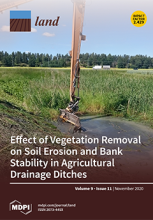/ library resources
Showing items 1 through 9 of 803.In this study, a knowledge-based fuzzy classification method was used to classify possible soil-landforms in urban areas based on analysis of morphometric parameters (terrain attributes) derived from digital elevation models (DEMs).
Spatially explicit assessments of ecosystem services (ES) potentials are a key component in supporting a sustainable land use management. The ES matrix method is a commonly used approach as it allows for a comparably fast, comprehensible and accessible ES assessment.
Maintenance of agricultural drainage ditches can be difficult to optimize if farmers have no guidelines on where to target their maintenance efforts. A main concern is whether ditch banks will experience soil erosion or mass movement (failure).
Rapid expansion of unsustainable farming practices in upland areas of Southeast Asia threatens food security and the environment. This study assessed alternative agroforestry systems for sustainable land management and livelihood improvement in northwest Vietnam.
Allotment gardens are quite common in many European countries. In particular, they are an important part of the urban space in Central and Eastern Europe.
The near elimination of inland salt marshes in Central Europe occurred throughout the 19th and 20th centuries, and the currently remaining marshes exist in a degraded condition.
The rain gardens at Bryggen in Bergen, Western Norway, is designed to collect, retain, and infiltrate surface rainfall runoff water, recharge the groundwater, and replenish soil moisture.
The forest and landscape restoration (FLR) targets set as part of the Bonn Challenge draw attention to the governance arrangements required to translate national FLR targets into local action.
Ecological Focus Areas (EFAs) have recently been introduced as key element in the greening of the EU’s Common Agricultural Policy. In 2015, farmers across the EU have implemented EFAs for the first time.
Paginação
Land Library Search
Through our robust search engine, you can search for any item of the over 73,000 highly curated resources in the Land Library.
If you would like to find an overview of what is possible, feel free to peruse the Search Guide.




